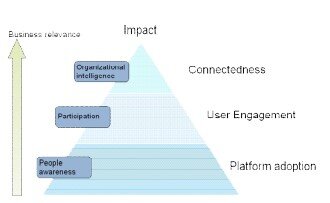Knowing-Doing Gap
In this post we continue to explore how we might better engage the “Long Tail” participants in our Enterprise Social Networking (ESN) communities. In 2000 Jeffey Pfeffer and Robert Sutton published their book entitled the “Knowing-Doing Gap: How Smart Companies Turn Knowledge into Action”. Its publication was timely for many of us working in Knowledge Management programs at the time as it reinforced to us that knowledge sharing alone is not enough. What they found in their research was that there were many under-performing companies who really didn’t have a knowledge problem. Their problem was more with actioning what they knew. For example, they talk about organisations who have a culture of fear, where staff were reluctant to take actions unless they were 100% sure of a positive outcome. A summary of their recommendations can be found in this FastCompany interview. In essence the authors recommend prioritising “action over words”. At times this may mean taking actions that could be considered ill-prepared for. However, they use the examples of Bill Gross’ Idea Lab and Thomas Edison’s Labs of learning environments, where ‘safe’ actions can be taken in the spirit of experimentation and learning, thereby generating tangible value for the organisation. In other words, “stop thinking about it and just try something!”.
Bridging the Knowing-Doing gap in ESNs
I recall one KM consulting assignment I had with a government organisation which had created a community of practice to share their learnings around the implementation of ERP software across the different agencies. The ‘behind the scenes’ agenda for the organisers was a hope that the agencies would collectively develop a common template that could accelerate the implementations across all agencies and achieve the economies of scale that were anticipated. When we analysed the social networks within the community we indeed found a fairly cohesive community. They met and shared their experiences regularly. However, frustratingly that was all they did. While my recommendation was to create some community projects that the members could work on collectively, this appeared to be ‘a bridge too far’ for them i.e. a “knowing-doing” gap.
In the context of today’s online communities, this could mean prioritising doing-activities e.g. projects, Q & A etc.. One organisation I worked for had spent multiple millions of dollars creating an enterprise wide “knowledge repository”. They also had a simple ‘Request for assistance’ Q&A system where anyone could post a question, which would be categorised and then released to the most appropriate communities for a response. The first facility was content centred, whereas the second was more action oriented. It’s not hard to guess which one ended up creating the most value.
Another common activity that was undertaken in KM, that is now pervading the ESN space, is maturity assessments. Typically, these frameworks describe organisational characteristics that might be observed at differing levels of maturity. The intent is for those responsible for say the ESN programme, to be able to assess where they are against where they could/should be. Unfortunately, the actions/interventions required to move an organisation’s ESN maturity are far from trivial or actionable at an enterprise level. One exception I have seen is the maturity framework used by Siemens. What is nice about this framework is the logical progression it makes from simple measures around platform access, through to participation, connection (which is equivalent to our social cohesion measure) and finally to business impact. Impact is measured by monitoring and valuing requests e.g. what would be the business value that would accrue, if this request could be successfully met. Impact is therefore measured through the assessed value of the request, and then an assessment of the degree to which the request has been fulfilled. With this level of detail, it would then be possible to audit against actual benefits achieved.
How Can you Assess your Own Online Knowing Doing Gap?
As we have suggested in prior posts, significant needs for change can be signaled from the top, but needs to be executed at the individual level. The challenge therefore is how to influence the “Long Tail” to not just become more active on the ESN, but for their participation to be less passive and more action oriented. Consider your own interactions, (or lack thereof) on your online communities and ask yourself:
How often have you shared a problem or challenge at work on the ESN?
How often have you responded to someone else’s question posted on the ESN?
When was the last time you took an action as an intentional experiment?
If you have, did you share the results?
When you see an idea that you don’t agree with, do you ignore it and do nothing; criticise it; or look for a constructive way to improve the idea?
When you have read something of value on the ESN can you recall any actions you took because of it?
Do you regularly acknowledge the author of content that you have found valuable?
Have you thought about using the ESN for your regular team communications? If not, why not?
Why not share questions like these with your “Long Tail” community members?
Organisations today are regularly complex and sometimes even chaotic. By taking a lead from the Cynefin complexity framework we should be regularly probing/experimenting to make better sense of the world; and in more chaotic situations, any action is better than none at all.



